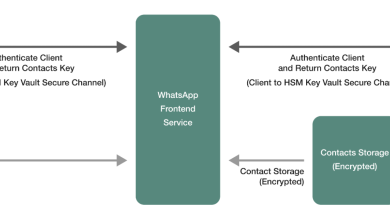12 Conversion Rate Optimization Tactics for your Shopify Store
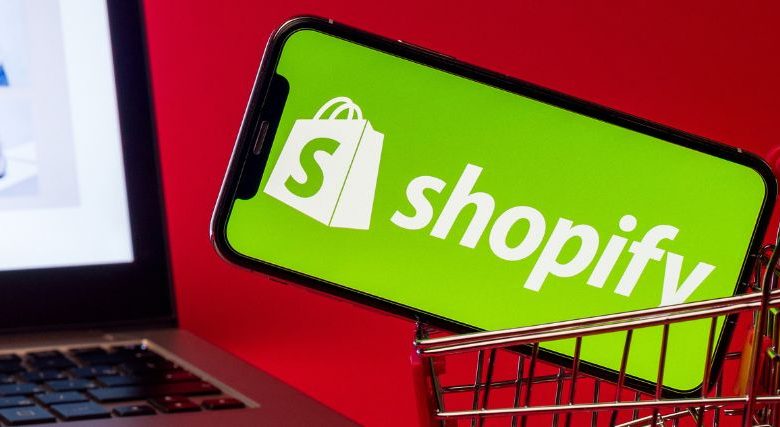
Mastering Shopify conversion rate optimization can seem like a complex process, particularly in 2024. While the ecommerce market is evolving at an incredible rate, with online sales predicted to amount to more than 8.1 trillion by 2026, buyer behaviors are constantly changing.
Consumers now demand smoother, more convenient, and more personalized online shopping experiences across multiple channels. The simplest thing, from the design of your product pages to the options consumers have on the checkout page, can reduce your conversion rates.
What’s more, since there are more than 4.5 million Shopify stores worldwide, the competition for customers is greater than ever.
The easiest way to increase conversion rates is to work with a CRO specialist capable of building a granular strategy for online success. However, there are various ways you can invest in Shopify conversion rate optimization yourself.
Here are some of the best, data-driven, and proven strategies that work for Shopify store owners.
What is Shopify Conversion Rate Optimization?
Conversion rate optimization (CRO) is the process of identifying and implementing strategies that incrementally improve your store conversion rates and increase your revenue. In different environments, CRO strategies can focus on various things, from increasing the number of customers who fill out a contact form to boosting your number of app downloads.
Shopify conversion rate optimization generally focuses on increasing the following:
- Online sales
- The number of visitors adding items to a cart
- Visitors adding items to a wishlist
- Visitors signing up for an account or newsletter
Industry leaders suggest the average conversion rate for most ecommerce stores is between 2.3-3%. However, Shopify stores have an average conversion rate closer to 1.4%. Notably, various factors (both internal and external) can influence your conversion rates.
Everything from your site’s performance and user experience (UX) to external buying trends influences how people shop on your website. That’s why Shopify conversion rate optimization is often a continuous process rather than a one-time task.
To increase conversion rate, Shopify vendors need to calculate their current conversion rate using the following formula: Conversions / Total visitors x 100 = Conversion rate. From there, they need to constantly evaluate, review, and learn from data to make granular improvements.
12 Conversion Rate Optimization Tactics for Shopify Stores
Ultimately, Shopify conversion rate optimization is the key to ensuring you generate more sales on your store, often from the same amount of traffic. It leads to a higher return on investment and increased profitability by optimizing every purchase.
So, how do you get started? Based on our own knowledge of the ecommerce landscape, we’ve found 12 amazing tactics that deliver constant results for online stores.
1. Gather Qualitative and Quantitative Data
As mentioned above, Shopify conversion rate optimization is a continuous process that relies on data. You need to learn as much as you can about your consumers, their purchasing behaviors, and the parts of your store that contribute to or detract from conversions to drive the right results.
You can start with concrete, quantitative data, looking at your traffic numbers, overall conversion rate, and other metrics that contribute to sales. Shopify has some fantastic built-in reporting features for tracking conversions and engagement, but you can expand on these with Google Analytics.
Google Analytics allows you to segment conversion rate insights by page, traffic channel, and other factors. This makes it easier to understand how different products, marketing campaigns, and parts of your website are driving conversions.
Once you have your quantitative data, build on it with qualitative insights. You can ask customers questions using automated surveys and pop-ups, as Bonia does here, to find out why they might not have made a purchase or what products they were looking for:
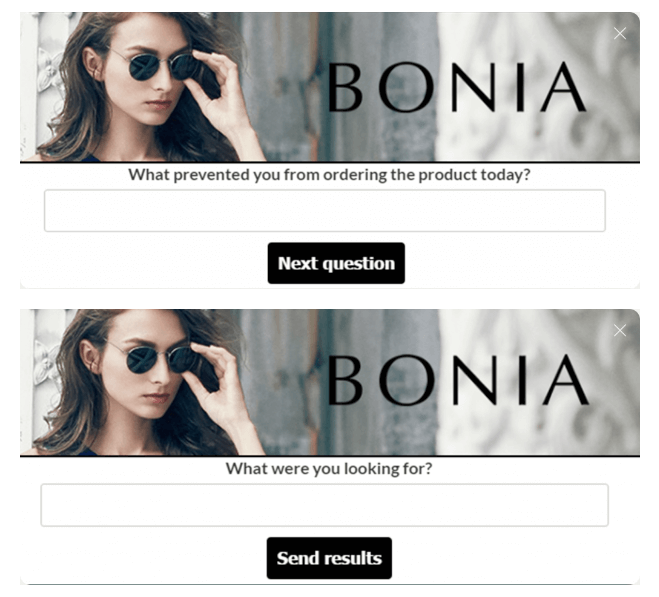
Alternatively, you can use Shopify chatbot integrations to gather insights from your customers, which can help you to create FAQs and better service experiences in the future. You could even simply analyze the reviews customers leave on your website, to find out more about what they think about your products, fulfillment process, and website experience.
The more data you collect, the easier it will be to make intelligent decisions about which parts of your website you need to optimize.
2. Optimize the User Experience
Studies show only 1% of users believe ecommerce websites meet their expectations every time. If your customers don’t get a great experience on your website, they’re not going to purchase anything. Even if you do earn conversions, you likely won’t get repeat customers.
That’s why it’s so important to ensure you’re optimizing every part of the customer journey. Start by examining the potential friction points on your website. For instance, are customers struggling to find the products they need on your category pages, or do they regularly abandon a page because it doesn’t include the right information? Customer surveys and heatmapping tools like Heatmap.com are excellent for learning more about the issues in the customer journey.
Using what you learn, tackle common issues like:
- Navigation: How easy is it for customers to search for and find the products they want? If you sell a lot of products, introducing an intelligent search bar could be a good idea. Some studies show around 69% of customers will head straight to the search bar on a store site.
- Create FAQs: Find out which questions your customers usually ask before they make a purchase, and ensure you answer them. You can create an FAQ page covering everything from refund and return policies to average shipping times.
- Add live chat: Adding live chat to your ecommerce website can increase your conversion rates by 40%. It gives customers an instant way to address any concerns they have about making a purchase, reducing friction points.
The Triangl store has an excellent live chat tab on their site, which even includes frequently asked questions and directs customers to pages where they can manage their orders:
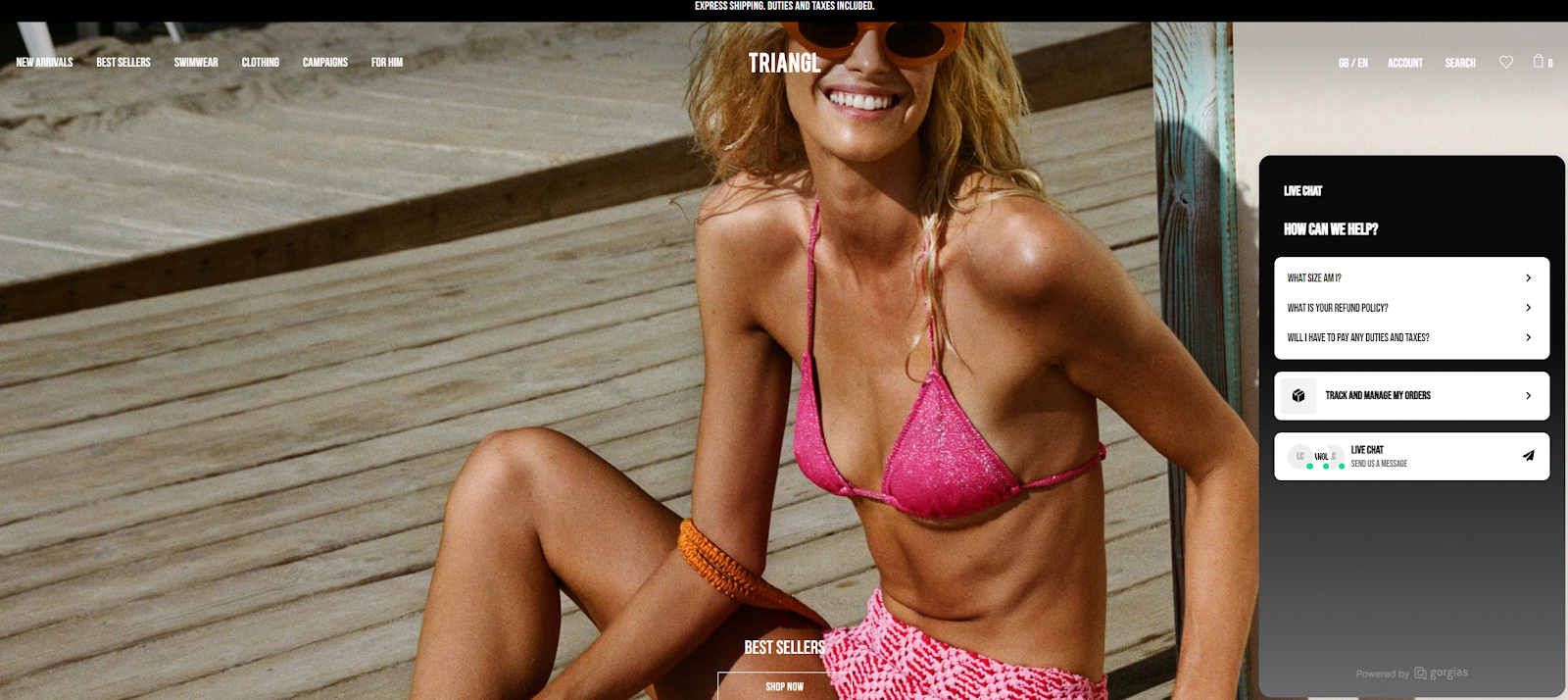
3. Make Your Value Proposition Clear
This might sound like an obvious Shopify conversion rate optimization tip, but it’s something a lot of companies frequently overlook. When consumers are shopping online, they don’t have the same access to information as they’d get in-store. They can’t pick up a product, interact with it, or discuss their needs with a sales assistant.
That means you need to take extra measures to ensure your value proposition stands out. There are a few great ways to do this, such as:
- Using high-quality images and videos: Images and videos are an excellent way to help customers see your products from every angle. On your product pages, an excellent selection of photos can significantly increase conversion rates. You can even introduce zoom options to help customers analyze the product or show the item being used by a person.
- Use banners to showcase offers: If you offer things like free returns or delivery, or you’re currently running a sale, make it easy for customers to find out straight away. Use banners or popups to draw attention to your latest offer.
- Demonstrate credibility: Highlight why customers should trust your store on your home page and product pages. Showcase where your products have been featured or how many great reviews they’ve earned, like HelmBoots.com does here:
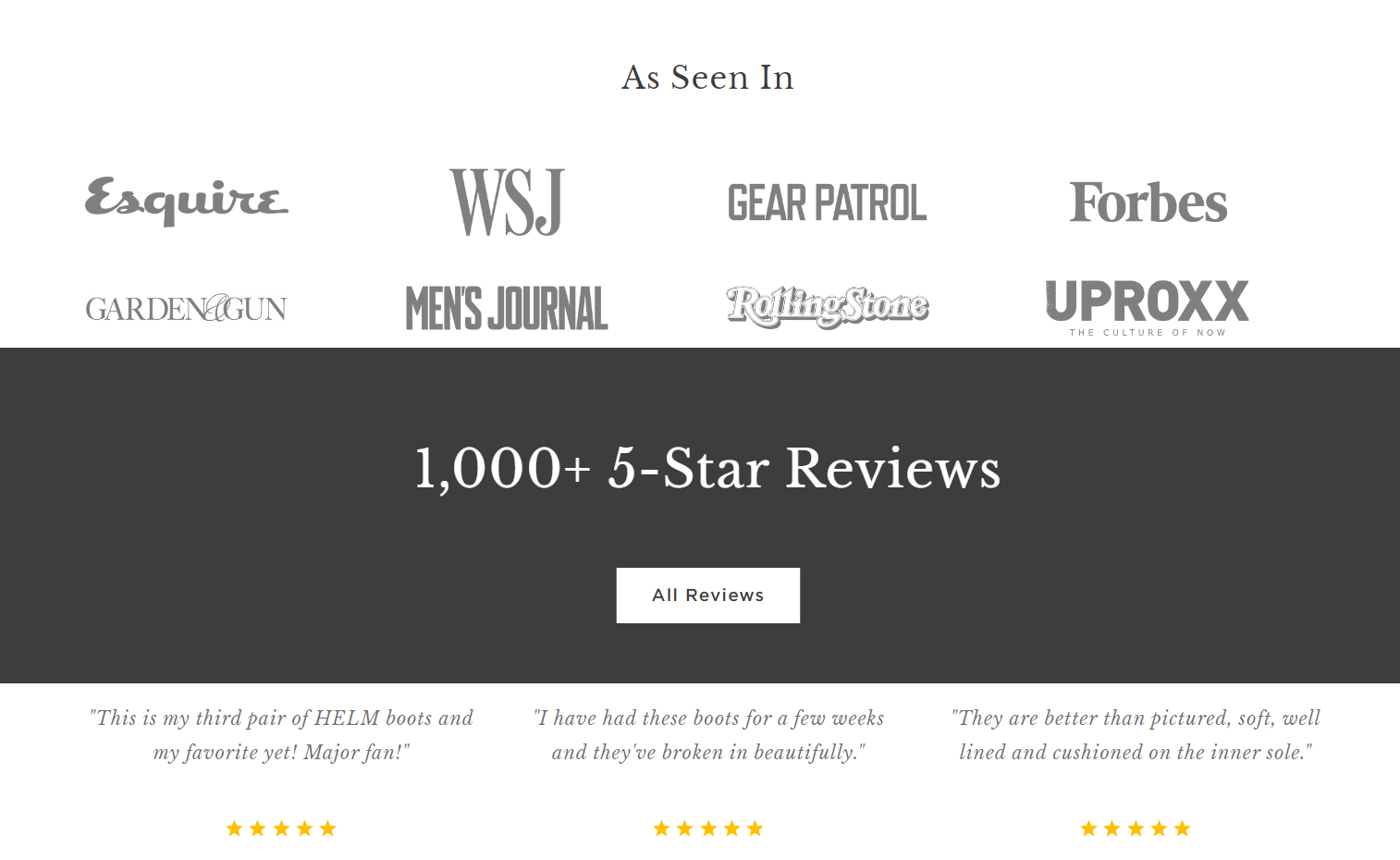
4. Introduce Social Proof
Building on our previous tip, one of the best ways to increase Shopify conversion rates and generate growth for your company is to leverage social proof. This could start with showcasing reviews and star ratings on your website. Around 72% of people read reviews before buying anything. If they can see reviews there on your website, they won’t have to abandon your site to search elsewhere.
Here’s a great example from Manitobah.com. They don’t just share reviews; they calculate a rating for each product based on the feedback they receive:

You could even create a review page with more in-depth testimonials and case studies from your bigger customers, depending on what you sell.
Another way to show social proof for Shopify conversion rate optimization is to use trust badges. Basically, these are badges that show customers they can rely on your store to keep their data and information safe. You can establish trust by:
- Installing an SSL certificate on your store
- Displaying images of the credit card and payment methods you accept
- Adding PayPal or McAfee security badges
- Sharing badges that show recently won awards or accolades
5. Reduce Abandoned Carts and Lost Sales
Sometimes, to increase conversion rate, Shopify vendors need to focus not just on increasing their chances of earning a sale but also on reducing the risk of losing a sale. Studies show only 2% of visitors to your website will turn into customers on their first visit.
That means you need a way to re-engage your customers and boost your chances of driving them back to your website. Here are a few great options to try:
- Use a “Notify Me” feature: If a product is out of stock when a customer first sees it, they might forget all about it by the time it becomes available again. Adding a “notify me” feature, which allows users to sign up for alerts when new stock becomes available, boosts your chances of driving customers back to your website.
- Use remarketing campaigns on other channels: If you integrate your Shopify store with channels like Facebook, you can use remarketing strategies to show personalized ads to consumers who have already visited your store and looked at a specific product. This is an excellent way to remind them to make a purchase.
- Try abandoned cart emails: If your customers are already signed up for an account with your website, abandoned cart emails can be a fantastic way to increase conversions. They can instantly remind your customers of the products they’ve looked at and the unique value your business has to offer.
Here’s a great example of an abandoned cart email from Nordstrom, which highlights the product the customer looked at, the site’s FAQ page, and their free shipping and free returns offer:
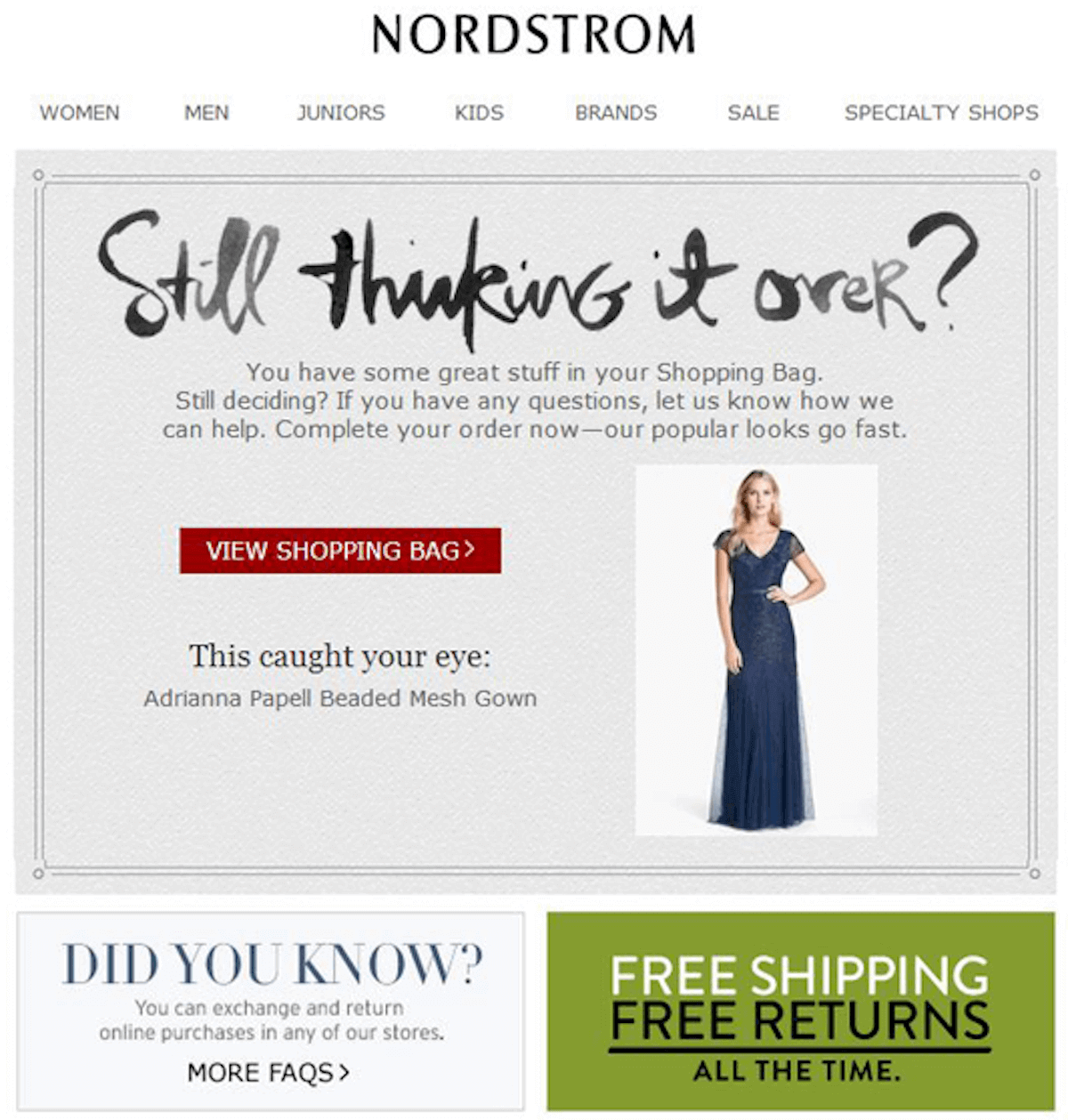
6. Optimize the Checkout Process
Speaking of abandoned carts, a poor checkout experience is one of the main reasons shoppers will end up leaving your website without making a purchase. One survey found that up to 21% of consumers abandon shopping carts if they feel the checkout experience is too complicated.
Fortunately, there are various ways you can improve the checkout experience. One option is to use clear progress indicators that show customers how close they are to making a purchase. Another is to give your customers a quick-buy option. For instance, Vienna allows customers to either add products to their cart and keep shopping or buy an item directly:
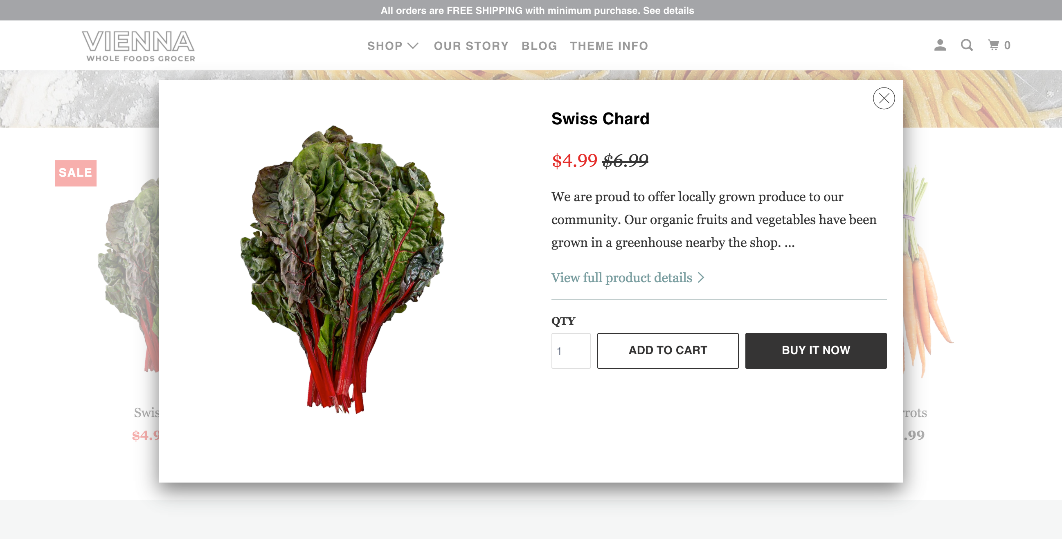
Other ways to transform the checkout experience include:
- Creating a one-page checkout: A simple checkout contained on a single page will usually be easier to navigate and more convenient for customers. Avoid adding too many fields, and consider using Shop Pay for instant checkout options.
- Offer multiple payment methods: Give your customers the freedom to use whichever payment method they prefer, from PayPal to buy-now-pay-later options.
- Guest checkout: Allow customers to checkout without creating an account. Around 34% of customers abandon carts because the store wants them to create an account before a purchase. Give your customers the option to checkout without a headache.
7. Increase Average Order Value
Shopify conversion rate optimization isn’t just about increasing your number of conversions. It’s also about finding a way to boost your average order value and customer lifetime value. There are a few ways you can increase your chances of customers making more substantial purchases.
One great option is to use upsell and cross-selling techniques, which are offered by integrations with Shopify. For instance, Quadlockcase.com suggests add-on items that might be beneficial to customers based on the product they’re looking at.
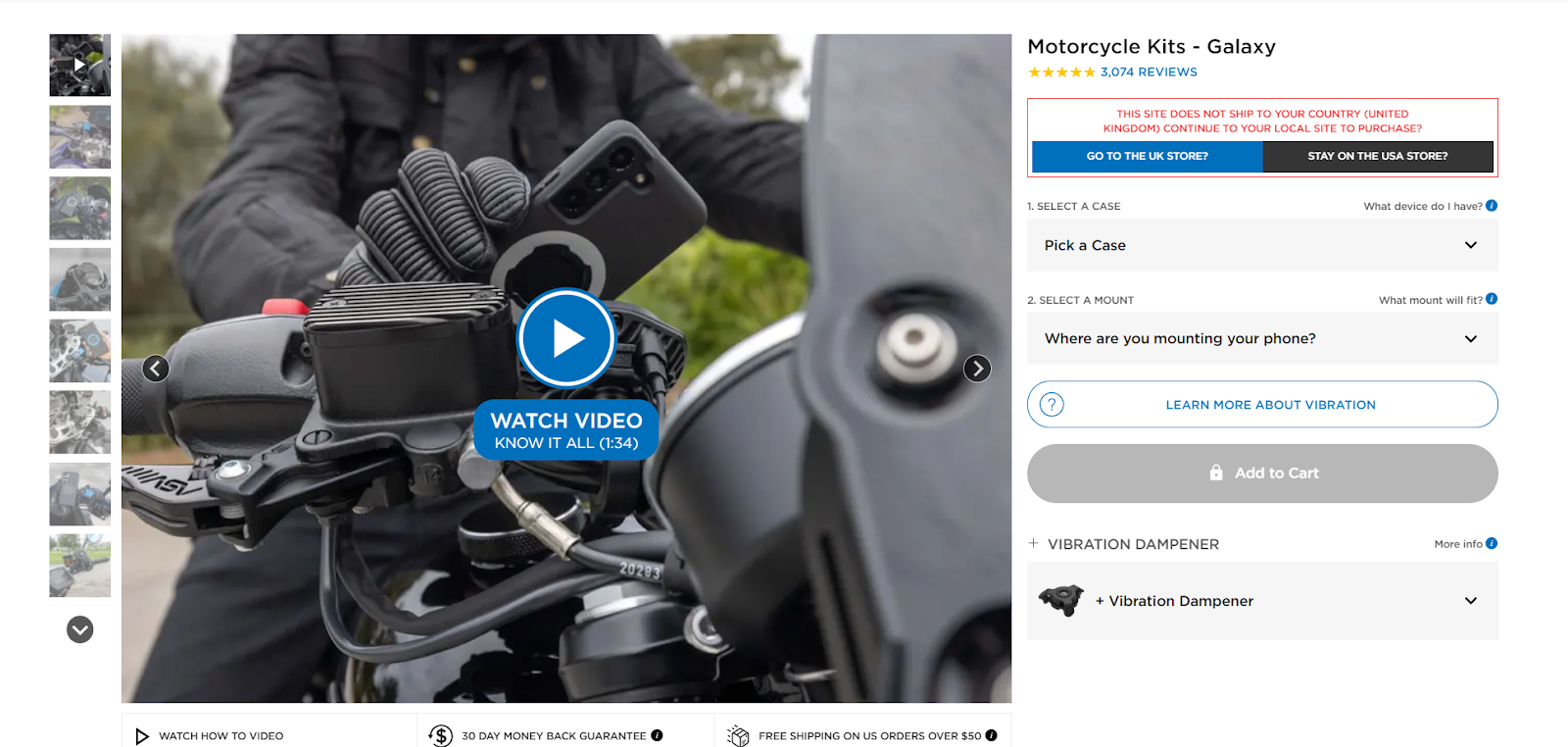
You could also use things like lookbooks to show customers how different items look together in the closing industry or “upsell” recommendations to help customers compare low-cost products with more expensive alternatives. Alternatively, you could consider creating unique product bundles with a discounted price for consumers who buy multiple items together.
Another option is to give shoppers an incentive to purchase more. For instance, you could promise customers free shipping or a free gift when they spend a certain amount.
8. Unlock the Power of FOMO
FOMO, or Fear of Missing Out, is still a very real phenomenon in 2024. Studies show that 60% of consumers who feel concerned about missing out on an offer will make a purchase within 24 hours. Fortunately, there are a number of ways you can leverage FOMO with Shopify apps.
For instance, you could share limited-time offers with customers by adding banners to product pages or using pop-ups to let them know when they can access an exclusive discount:
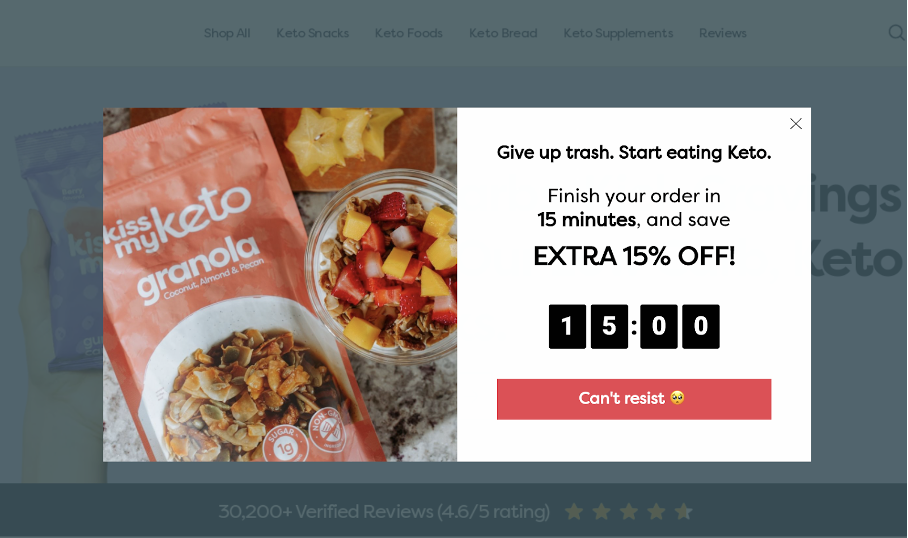
Other options include:
- Using low-stock notifications to alert customers when a popular item is running out of stock.
- Showcasing real-time purchases and social proof notifications on your website.
- Adding countdowns and timers to your homepage for flash sales
Notably, your offers don’t always have to involve giving customers money off a purchase. You could also offer access to limited-time express delivery or free delivery to increase conversions. This could be a great way to boost sales without harming your profit margins.
9. Share Crucial Information Clearly
While today’s consumers are more trusting of online stores than they once were, their opinions of your company can be easily tarnished if you’re not transparent in your communications. Your customers want to know exactly when they’re going to receive their product, what your returns and refund policy looks like, and, most importantly, how much they’re going to pay.
Nobody wants to add a product to their checkout, assuming they’ll pay a certain price, only to be bombarded by extra fees for tax and shipping. In fact, around 55% of customers bounce from a website because of extra costs they weren’t expecting.
With this in mind, make sure you’re clear about what customers can expect from your website. You can add shipping and delivery costs to your product pages or use a banner, like Gymshark does, to clearly outline your shipping costs, times, and other factors.
This banner on the Gymshark website tells customers how much they need to pay to get free delivery, what their returns policy looks like, and which discounts are available.

Additionally, if there are any fees for anything else, such as tax, make sure you mention this on your product page to reduce the risk of price shock.
10. Leverage Personalization
Personalization is one of the best ways to master Shopify conversion rate optimization in 2024. Today, around 51% of consumers expect their favorite brands to anticipate their needs, make relevant suggestions, and personalize the experience. If you can offer a more bespoke experience to your customers, you can increase your sales by around 20%.
One of the easiest ways to personalize the experience for customers is to suggest products they might be interested in based on their previous purchases. There are apps you can add to Shopify that allow you to make suggestions for customers with accounts on your websites, leveraging their order history and first-party cookies:

here (optional)
Other options include using a personalized product recommendation app or bot that uses artificial intelligence to suggest products to your customers based on which pages they visit or which products they’ve purchased before.
You can also deliver more personalized experiences through segmented email marketing. Divide your email contacts into segmented lists so you can share offers and product recommendations with them based on specific characteristics.
11. Use SEO Tactics
If you want to increase sales on your website, you also need to increase traffic. SEO, or Search Engine Optimization, can help with this. Writing keyword-optimized content for your product landing pages or producing blog posts for different stages of the customer journey can deliver a range of benefits.
It helps you rank higher on the search result pages when customers search for specific terms. Plus, it ensures you can educate your audience, answer their questions, and address any objections they might have to making a purchase. SEO tactics also improve the user experience, ensuring your customers can easily compare products, find the right items, and use your website effectively.
Here’s a great example from BeardBrand, a company that posts content relevant to men’s grooming to showcase their authority and expertise:

Remember, when you’re investing in SEO, don’t just think about keywords and content. Look at the technical side, too. Problems with things like page loading speed and page performance can reduce your rankings on search engines and minimize conversions. You can invest in SEO apps for Shopify to prevent these issues. By optimizing eCommerce sites, businesses can improve their conversion rates, increase customer satisfaction, and ultimately drive more sales and revenue.
Ensure your website works well on all devices (including mobiles) and that all of your pages load quickly, with no errors. This should improve your ranking potential and give you a better chance of converting your customers.
12. A/B Test Everything
Finally, the key to effective Shopify conversion rate optimization is testing. As we mentioned above, you need data to ensure you’re making the right changes to your site, delivering great experiences to your customers, and even producing the right products.
One of the best ways to ensure the changes you make to your site have a positive impact is to A/B test every part of the buyer journey. Here are just some of the things you can test:
- Imagery: The photos you use on your website and product pages, videos, and any other visual content that might help to increase sales.
- CTAs: Call to action buttons, banners, and links. Play with the colors and the position of your CTAs to see what drives the best result.
- Checkout options: Experiment with everything from payment options to the structure of your checkout and even guest checkout options.
- Social proof: Explore different placements for your reviews, testimonials, and trust badges to see whether they increase your conversions.
- Content: Test different versions of your product descriptions and page copy, using unique words to attract and engage your customers.
You can also experiment with different offers, such as free shipping, express delivery on certain products, or different sale tactics. Some ecommerce companies A/B test their pricing strategies, and many regularly A/B test different marketing campaigns, like social media, email, and content marketing strategies. The more you test, the more likely you’ll be to achieve the right results.
Mastering Shopify Conversion Rate Optimization
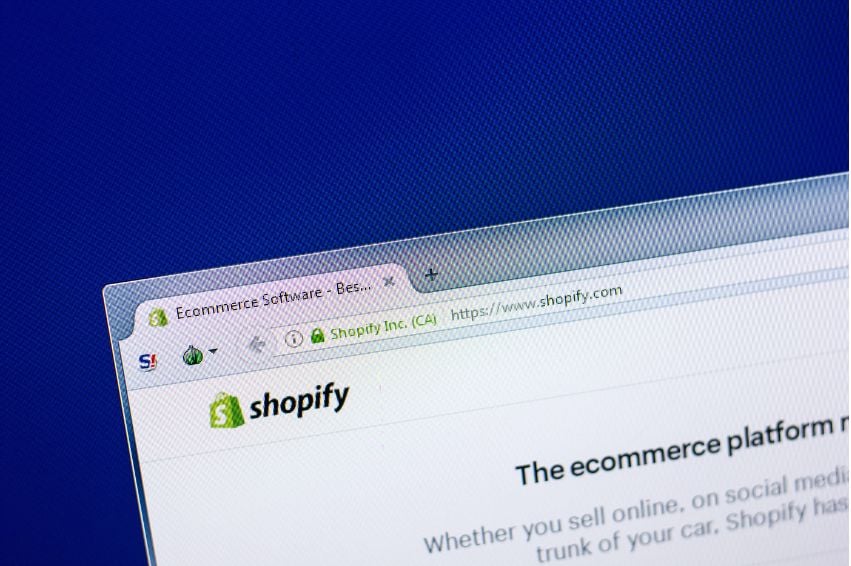
To increase conversion rates, Shopify business owners need to constantly invest in finding new ways to attract and engage their audience, increase order value, and boost repeat visits. It’s a continuous process that requires significant work and strategy.
However, if you can master Shopify conversion rate optimization, the results can be incredible. The right tactics can give you an edge over the competition, increase your revenue, and even provide useful insights into your target audience and their preferences.
If you need help with Shopify conversion rate optimization, reach out to Toptal for support from a specialist with CRO skills.
FAQ
How do I optimize the conversion rate in Shopify?
There are various ways to optimize Shopify conversion rates, from increasing website speed and performance to simplifying the checkout process, offering unique benefits to customers, and even running flash sales or promotions.
What’s the best conversion rate for a Shopify store?
The average conversion rate on Shopify is around 1.4%. A good conversion rate would be anywhere over this number. However, anything above 3.7% would place you in the top 20% of all Shopify stores for conversion rates.
Why is my Shopify conversion rate low?
Various factors can contribute to a low conversion rate. You may not be offering the best user experience, or customers could be having a hard time finding the products they need. You might even find your customers are struggling to see the value in your products.
How do I fix the low conversion rate on Shopify?
Explore a range of strategies, from offering first-time offers to new customers, free shipping, and providing coupon codes. You can also invest in strategies to reduce cart abandonment, such as using retargeting ads and upgrading the performance of your store.
What’s a good conversion rate for ecommerce?
Most experts believe a good conversion rate for an ecommerce store is somewhere between 2.5% and 3%. However, the average conversion rate for your store can vary depending on a number of factors, including the industry you serve.



